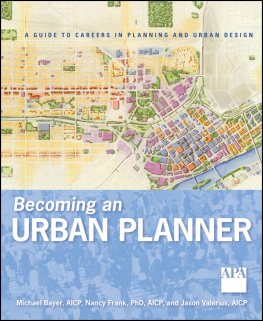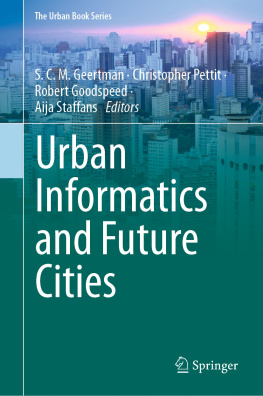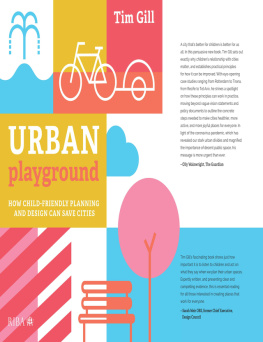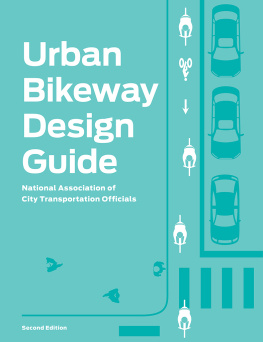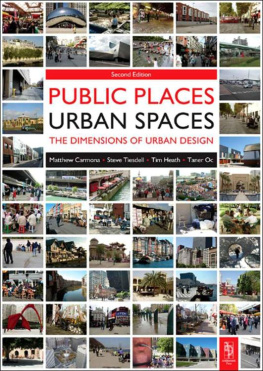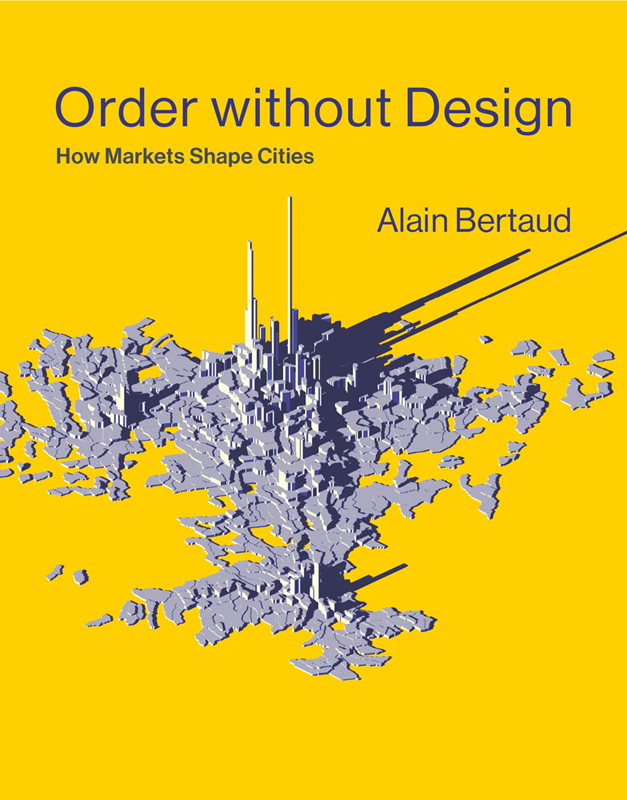All rights reserved. No part of this book may be reproduced in any form by any electronic or mechanical means (including photocopying, recording, or information storage and retrieval) without permission in writing from the publisher.
This book was set in Palatino by Westchester Publishing Services. Printed and bound in the United States of America.
Names: Bertaud, Alain, author.
Title: Order without design : how markets shape cities / Alain Bertaud.
Description: Cambridge, MA : MIT Press, [2018] | Includes bibliographical references and index.
Identifiers: LCCN 2018008743 | ISBN 9780262038768 (hardcover : alk. paper)
Subjects: LCSH: Urban economics. | City planning.
Contents
List of Figures
Distribution of commuting times in US cities, Paris, and in Gauteng, South Africa. Sources: United States: US Census Bureau, 2010 American Community Survey, tables S0802 and B08303; South Africa: Statistics South Africa, Department of Transport Gauteng Households Travel Survey, figure 3.10, Pretoria, South Africa, 2009; Paris: Direction des statistiques dmographiques et sociales, Enqute nationale transport et dplacements 20072008, Institut national de la statistique et des tudes conomiques, Paris, 2011.
Distribution of workers residences and job locations in a hypothetical linear city.
Labor market type, speed of travel, and job location.
Average number of jobs accessible to workers in various US cities, 2010.
The labor market shapes the pattern of commuting trips. Source: David Levinson, Access across America, Center for Transportation Studies, University of Minnesota, Minneapolis, 2013.
Model trip patterns in metropolitan areas.
Trip patterns in metropolitan Paris. Sources: Les dplacements des Franciliens en 20012002, Direction regionale de lequipement dle-de-France, 2005, Paris Cedex 15; built-up area, digitization of satellite imagery by Marie-Agnes Bertaud.
Changes in population and job distributions over time, Seoul metropolitan area. Sources: Population and job data: Seoul Metropolitan Government Statistical Unit, Census 2000, 2010; built-up areas and densities: GIS analysis by Marie-Agnes Bertaud.
Vacant cotton mills in Mumbai, 1990.
Street patterns in New York (Wall Street area) and in Paris (Marais).
Plan of Miletus, sixth century B . C . Source: Illustration by A. V. Gerkan and B. F. Weber, 1999, in The Archaeology of Byzantine Anatolia: From the End of Late Antiquity until the Coming of the Turks, ed. Philipp Niewhner (Oxford: Oxford University Press, 2017).
The author, with his two assistants, tracing new streets in Yemen, 1970.
Le Corbusiers Plan Voisin for Paris. Sources: Paris built-up background map: OpenStreetMap; Plan Voisin: three-dimensional model by author based on plans and drawings from the Fondation Le Corbusier website and from Le Corbusier, The City of Tomorrow and Its Planning (New York: Dover Publications, Inc., 1987).
Application of the sun rulefootprint of danwei housing in Beijing, Ningbo, and Guangzhou.
Distance between buildings in China, determined by the angle of the sun on the winter solstice.
The design of buildings in a block in Chandigarh (left) and Braslia (right). Sources: Topographical maps with built-up areas from Department of Urban Planning Chandigarh Administration, 2005, updated with the help of Google Earth satellite imagery, 2008.
Pudong: Shanghais new financial center.
The design and construction of roads and subway links to Pudong, 1992 and 2013.
Relationship between population, land, and floor space consumption. It is assumed that prices are set by market supply, and demand/supply are constrained by topography and other variables.
Profile of land price versus distance from city center.
Calculation of the density gradient using a regression based on observed densities in a real city.
Profile of densities in 12 metropolises.
Profile of land prices in Paris, 1990.
Density profile of Los Angeles. Sources: Population: US Census data, 2000; built-up area: interpretation and vectorization of satellite imagery by Marie-Agnes Bertaud.
Schematic representation of access to the labor market in a city with a uniform distribution of job locations.
Moscow population density profile, 1989. Sources: 1989 All-Union Census data, State Committee for Statistics Moscow, 1990; vectorization of satellite imagery by author.
Change over time in the density gradients in Tianjin (1988 and 2000) and Paris (1990 and 2006). Sources: Tianjin Population Census and Survey data, Tianjin Statistical Yearbook, Tianjin; Paris Population 1990 National Census, population 2006 estimate by Institut National de la Statistique et des tudes conomiques, Paris; vectorization of satellite data by Marie-Agnes Roy Bertaud.
Sale price and rents of very small apartments in Paris, 2014.
Price of urban land and agricultural land define the limit of urbanization.
Limit of urbanization when agricultural land prices are distorted.
Built-up area and premier cru vineyards, Beaune.
Profile of urban and agricultural land prices along the AB axis, Beaune.
Limit of urbanization, taking into account the cost of land development.
Existing villages east of the immediate expansion area of Luoyang, China. Source: Vectorization of Google Earth Images, 2015; population estimates based on village surveys.
Informal subdivision at the fringe of urbanization in Mexico City (left image) and Surabaya, Indonesia (right image; same scale for both images).
Hanoi existing land use in 2010 and Hanois capital master plan for 2030.
Mode share work at home versus public transport in some US cities. Source: Wendell Cox, NewGeography, May 30, 2015.
Accessibility of a suburban location in Buenos Aires by public transport and by car. Source: Wb.BA.analyst.conveyal.com.
Modes of urban transport.
Changes in the dominant transport mode, Beijing (left) and Hanoi (right). Source: Beijing Transport Research Center, 2015.
.
Average door-to-door public transport travel time for commuters in the Paris municipality and Beijing metropolitan area. Sources: Data for Paris: Etude sur les deplacements, Regie Autonome des Transports Parisiens, 2014; Beijing: Beijing, the 4th Comprehensive Transport Survey Summary Report, Beijing Transportation Research Center (BTRC), Beijing Municipal Commission of Transport, Beijing, China, 2012.
Door-to-door commuting time from suburb to downtown New York (case study, no statistical significance).
Extreme commuting in Gauteng (South Africa) case study. Source: National Development Plan Vision 2030, Presidents National Planning Commission, South Africa, 2011.
Average commuting travel time by transport mode, Singapore, Hong Kong, DallasFort Worth, Paris, and New York. Sources: Data for United States: Commuting in America 2013, US DOT Census Transportation Planning Products Program, Washington, DC, 2013; Paris: Les deplacements des Franciliens en 20012002, Direction rgionale de lquipement dle-de-France, Paris, 2004; Hong Kong: Travel Characteristics Survey-Final Report 2011, Transport Department, Government of Hong Kong Special Administrative Region, Hong Kong, 2011; Singapore: Singapore Land Transport Statistics in Brief 2010, Land Transport Authority, Singapore Government, Singapore, 2010.


